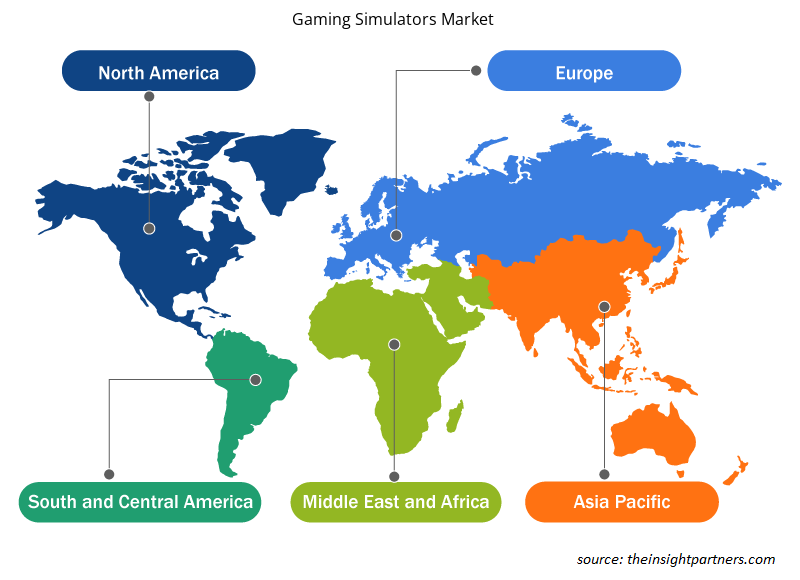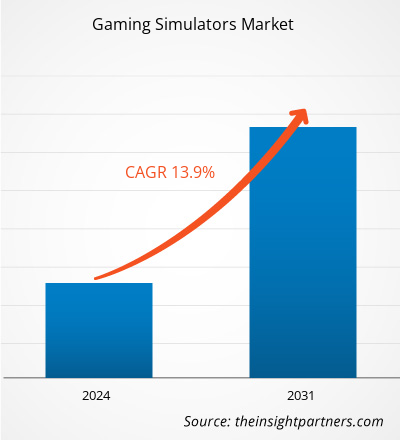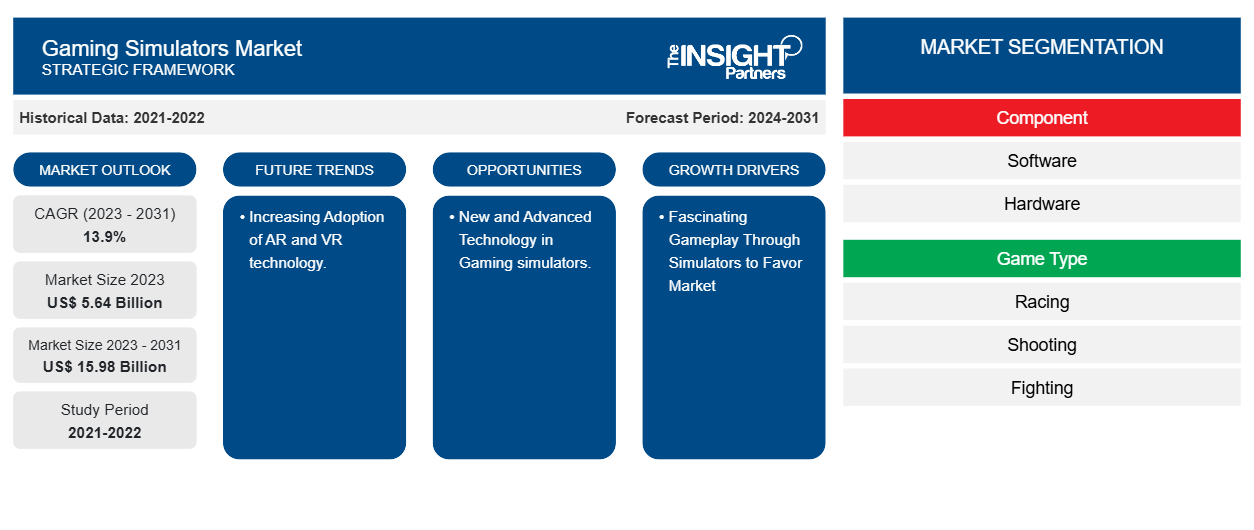Der Markt für Spielsimulatoren soll von 5,64 Milliarden US-Dollar im Jahr 2023 auf 15,98 Milliarden US-Dollar im Jahr 2031 anwachsen. Der Markt wird voraussichtlich zwischen 2023 und 2031 eine durchschnittliche jährliche Wachstumsrate von 13,9 % verzeichnen. Die wachsende Zahl von E-Sport-Wettbewerben und die Integration von AR und VR werden voraussichtlich weiterhin wichtige Markttrends für Spielsimulatoren bleiben.
Marktanalyse für Spielsimulatoren
Da Simulationsspiele den traditionellen Spielen vorgezogen werden und Live-Gaming-Erlebnisse stärker nachgefragt werden, wird der Markt für Online-Simulationsspiele voraussichtlich wachsen. Die Nachfrage der Verbraucher nach Virtual Reality (VR)-Headsets und die wachsende Zahl von Unternehmen, die Gaming-Simulationen für Training und Analyse nutzen, treiben das Wachstum des weltweiten Gaming-Simulationsmarktes voran.
Marktübersicht für Spielsimulatoren
Ein Tool der Spielebranche zur Simulation realer Szenarien ist die Spielsimulation. Ihre Bestandteile – Systemeinheiten, Eingabevariablen, Leistungsmetriken und funktionale Beziehungen – arbeiten alle zusammen, um das Spielerlebnis zu verbessern und den Spielern das bestmögliche Spielerlebnis zu bieten. Darüber hinaus nutzen immer mehr Unternehmen Spielsimulationen, um die Betriebskosten für die Mitarbeiterschulung zu senken, was wiederum das Wachstum des Marktes vorantreibt.
Passen Sie diesen Bericht Ihren Anforderungen an
Sie erhalten kostenlos individuelle Anpassungen an jedem Bericht, einschließlich Teilen dieses Berichts oder einer Analyse auf Länderebene, eines Excel-Datenpakets sowie tolle Angebote und Rabatte für Start-ups und Universitäten.
-
Holen Sie sich die wichtigsten Markttrends aus diesem Bericht.Dieses KOSTENLOSE Beispiel umfasst eine Datenanalyse von Markttrends bis hin zu Schätzungen und Prognosen.
Treiber und Chancen auf dem Markt für Spielsimulatoren
Faszinierendes Gameplay durch Simulatoren zur Förderung des Marktes
Der Bedarf an Internetzugang, die Verfügbarkeit und Erschwinglichkeit von Smartphones, die gesunkenen Technologiekosten pro Megabyte Daten und das Fehlen eines Festnetzanschlusses in einigen Entwicklungsländern sind einige der Gründe, die in ihrer Kombination die mobile Breitbandverbindung weltweit vorantreiben. Darüber hinaus geben laut einer Studie des Branchenriesen Google, Inc. rund 93 % der Smartphone-Nutzer an, dass sie ihre Geräte hauptsächlich zu Hause verwenden. Infolgedessen erlebt der Markt aufgrund der zunehmenden Akzeptanz der mobilen Breitbandverbindung unter den Branchenteilnehmern einen erheblichen technologischen Fortschritt. Der Markt für mobile Breitbandverbindungen wird voraussichtlich wachsen, was sich Jahr für Jahr positiv auf den Markt für drahtlose Router auswirken sollte.
Neue und fortschrittliche Technologie in Spielesimulatoren.
Neue und fortschrittliche Technologien in Spielesimulatoren bieten zahlreiche Möglichkeiten. AR- und VR-Technologien sowie haptische Feedbacksysteme sorgen für ein intensiveres Spielerlebnis und ziehen mehr Benutzer zu Spielesimulatoren. Darüber hinaus verbessern fortschrittliche Grafik-, Physik-Engines und Motion-Capture-Techniken den Realismus von Spielesimulationen und machen sie für Spieler attraktiver, die authentische Erlebnisse suchen.VR and haptic feedback systems provide a more gamers who seek authentic experiences.
Segmentierungsanalyse des Marktberichts für Spielsimulatoren
Wichtige Segmente, die zur Ableitung der Marktanalyse für Spielesimulatoren beigetragen haben, sind Komponente, Spieltyp und Endbenutzer.
- Basierend auf den Komponenten ist der Markt für Spielsimulatoren in Software und Hardware unterteilt. Das Softwaresegment dürfte im Prognosezeitraum wachsen.
- Nach Spieltyp ist der Markt in Rennspiele, Schießspiele, Kampfspiele und andere unterteilt. Das Rennsportsegment dürfte im Prognosezeitraum wachsen.
- Basierend auf den Endnutzern ist der Markt für Spielsimulatoren in Unterhaltung sowie Bildung und Training unterteilt. Das Markensegment dürfte im Prognosezeitraum wachsen.
Marktanteilsanalyse für Spielsimulatoren nach Geografie
Der geografische Umfang des Berichts zum Markt für Spielsimulatoren ist hauptsächlich in fünf Regionen unterteilt: Nordamerika, Asien-Pazifik, Europa, Naher Osten und Afrika sowie Südamerika/Süd- und Mittelamerika. Nordamerika hat den Markt für Spielsimulatoren dominiert. Hochtechnologische Trends in verschiedenen Branchen in der nordamerikanischen Region haben das Wachstum des Marktes für Spielsimulatoren vorangetrieben. Faktoren wie die zunehmende Einführung digitaler Tools und hohe Technologieausgaben von Regierungsbehörden werden voraussichtlich das Wachstum des nordamerikanischen Marktes für Spielsimulatoren vorantreiben. Darüber hinaus werden die wachsende Zahl von E-Sport-Wettbewerben und die Integration von AR und VR wahrscheinlich weiterhin wichtige Markttrends für Spielsimulatoren bleiben.
Darüber hinaus zwingt eine starke Betonung von Forschung und Entwicklung in den entwickelten Volkswirtschaften der USA und Kanadas die nordamerikanischen Akteure dazu, technologisch fortschrittliche Lösungen auf den Markt zu bringen. Darüber hinaus gibt es in den USA eine große Anzahl von Akteuren auf dem Markt für Spielsimulatoren, die sich zunehmend auf die Entwicklung innovativer Lösungen konzentrieren. All diese Faktoren tragen zum Wachstum des Marktes für Spielsimulatoren in der Region bei.
Regionale Einblicke in den Markt für Spielsimulatoren
Die regionalen Trends und Faktoren, die den Markt für Spielsimulatoren im Prognosezeitraum beeinflussen, wurden von den Analysten von Insight Partners ausführlich erläutert. In diesem Abschnitt werden auch die Marktsegmente und die Geografie von Spielsimulatoren in Nordamerika, Europa, im asiatisch-pazifischen Raum, im Nahen Osten und Afrika sowie in Süd- und Mittelamerika erörtert.

- Holen Sie sich die regionalen Daten für den Markt für Spielsimulatoren
Umfang des Marktberichts zu Spielsimulatoren
| Berichtsattribut | Details |
|---|---|
| Marktgröße im Jahr 2023 | 5,64 Milliarden US-Dollar |
| Marktgröße bis 2031 | 15,98 Milliarden US-Dollar |
| Globale CAGR (2023 - 2031) | 13,9 % |
| Historische Daten | 2021-2022 |
| Prognosezeitraum | 2024–2031 |
| Abgedeckte Segmente |
Nach Komponente
|
| Abgedeckte Regionen und Länder |
Nordamerika
|
| Marktführer und wichtige Unternehmensprofile |
|
Dichte der Marktteilnehmer für Spielsimulatoren: Die Auswirkungen auf die Geschäftsdynamik verstehen
Der Markt für Spielsimulatoren wächst rasant, angetrieben durch die steigende Nachfrage der Endnutzer aufgrund von Faktoren wie sich entwickelnden Verbraucherpräferenzen, technologischen Fortschritten und einem größeren Bewusstsein für die Vorteile des Produkts. Mit steigender Nachfrage erweitern Unternehmen ihr Angebot, entwickeln Innovationen, um die Bedürfnisse der Verbraucher zu erfüllen, und nutzen neue Trends, was das Marktwachstum weiter ankurbelt.
Die Marktteilnehmerdichte bezieht sich auf die Verteilung der Firmen oder Unternehmen, die in einem bestimmten Markt oder einer bestimmten Branche tätig sind. Sie gibt an, wie viele Wettbewerber (Marktteilnehmer) in einem bestimmten Marktraum im Verhältnis zu seiner Größe oder seinem gesamten Marktwert präsent sind.
Die wichtigsten auf dem Markt für Spielsimulatoren tätigen Unternehmen sind:
- CXC-SIMULATIONEN
- Hammacher Schlemmer & Company, Inc.
- Trak Racer
- Rennsport der nächsten Stufe
- VI-grade GmbH
- Der Playseat
Haftungsausschluss : Die oben aufgeführten Unternehmen sind nicht in einer bestimmten Reihenfolge aufgeführt.

- Überblick über die wichtigsten Akteure auf dem Markt für Spielsimulatoren
Neuigkeiten und aktuelle Entwicklungen zum Markt für Spielsimulatoren
Der Markt für Spielsimulatoren wird durch die Erfassung qualitativer und quantitativer Daten nach Primär- und Sekundärforschung bewertet, die wichtige Unternehmensveröffentlichungen, Verbandsdaten und Datenbanken umfasst. Im Folgenden finden Sie eine Liste der Entwicklungen auf dem Markt:
- Im November 2023 stellte Next Level Racing den brandneuen Next Level Racing GTRacer vor. Das Cockpit des GTRacer-Simulators wurde speziell entwickelt, um Rennsportbegeisterten ein immersives Rennerlebnis im GT-Stil in einem erschwinglichen Paket zu bieten.
(Quelle: Next Level Racing, Pressemitteilung, 2023)
- Im November 2023 kündigte VI-grade, einer der globalen Anbieter von menschenzentrierten, simulationsgesteuerten Fahrzeugentwicklungslösungen, die Einführung des DiM300-Fahrsimulators an, einer erweiterten Version seiner hochgelobten DiM DYNAMIC-Fahrsimulatortechnologie. Dieser neue, fortschrittliche Simulator stellt die neueste Weiterentwicklung der Großsimulatoren von VI-grade dar und baut auf dem Erfolg der preisgekrönten Modelle DiM150 und DiM250 auf.
(Quelle: VI-grade, Pressemitteilung, 2023)
Marktbericht zu Spielsimulatoren – Abdeckung und Ergebnisse
Der Bericht „Marktgröße und Prognose für Spielesimulatoren (2021–2031)“ bietet eine detaillierte Analyse des Marktes, die die folgenden Bereiche abdeckt:
- Marktgröße und Prognose auf globaler, regionaler und Länderebene für alle wichtigen Marktsegmente, die im Rahmen des Projekts abgedeckt sind
- Marktdynamik wie Treiber, Beschränkungen und wichtige Chancen
- Wichtige Zukunftstrends
- Detaillierte PEST/Porters Five Forces- und SWOT-Analyse
- Globale und regionale Marktanalyse mit wichtigen Markttrends, wichtigen Akteuren, Vorschriften und aktuellen Marktentwicklungen
- Branchenlandschaft und Wettbewerbsanalyse, einschließlich Marktkonzentration, Heatmap-Analyse, prominenten Akteuren und aktuellen Entwicklungen
- Detaillierte Firmenprofile
- Historische Analyse (2 Jahre), Basisjahr, Prognose (7 Jahre) mit CAGR
- PEST- und SWOT-Analyse
- Marktgröße Wert/Volumen – Global, Regional, Land
- Branchen- und Wettbewerbslandschaft
- Excel-Datensatz
Aktuelle Berichte
Verwandte Berichte
Erfahrungsberichte
Grund zum Kauf
- Fundierte Entscheidungsfindung
- Marktdynamik verstehen
- Wettbewerbsanalyse
- Kundeneinblicke
- Marktprognosen
- Risikominimierung
- Strategische Planung
- Investitionsbegründung
- Identifizierung neuer Märkte
- Verbesserung von Marketingstrategien
- Steigerung der Betriebseffizienz
- Anpassung an regulatorische Trends























 Kostenlose Probe anfordern für - Markt für Spielesimulatoren
Kostenlose Probe anfordern für - Markt für Spielesimulatoren